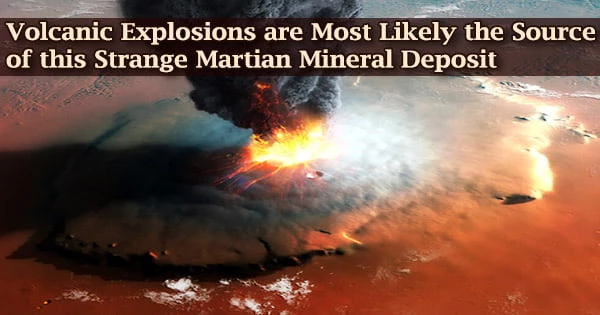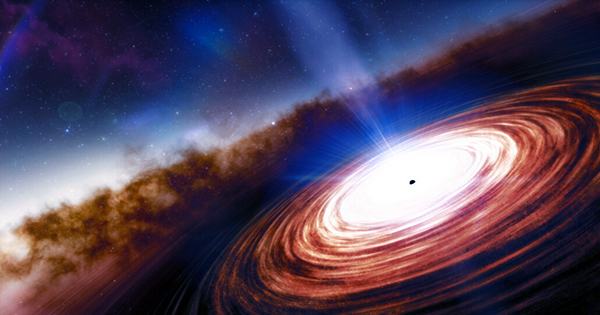According to a new analysis, ashfall from ancient volcanic eruptions is the most likely source of a unique mineral deposit near the landing site for NASA’s next Mars rover. The findings, which were published in the journal Geology, could aid scientists in compiling a history of early Mars volcanic activity and environmental conditions.
“This is one of the most tangible pieces of evidence yet for the idea that explosive volcanism was more common on early Mars,” said Christopher Kremer, a graduate student at Brown University who led the work.
“Understanding how important explosive volcanism was on early Mars is ultimately important for understand the water budget in Martian magma, groundwater abundance, and the thickness of the atmosphere.”
When gases such as water vapor are dissolved in subsurface magma, volcanic explosions occur. When the dissolved gas’s pressure exceeds the capacity of the rock above it, it bursts, shooting a blazing cloud of ash and lava into the air.
These kind of eruptions, according to scientists, should have occurred far earlier in Martian history, when there was more water available to mix with magma. The volcanic outbursts would have tapered down as the planet dried up, giving way to more effusive volcanism and a gentler pouring of lava onto the surface.
This is one of the most tangible pieces of evidence yet for the idea that explosive volcanism was more common on early Mars. Understanding how important explosive volcanism was on early Mars is ultimately important for understand the water budget in Martian magma, groundwater abundance, and the thickness of the atmosphere.
Christopher Kremer
On the Martian surface, there’s plenty of evidence of an effusive phase, but evidence of the early explosive phase has been difficult to find with orbiting instruments, according to Kremer.
This latest study looked at a deposit in the Nili Fossae region, which has long piqued scientists’ interest. The mineral olivine, which is ubiquitous in planetary interiors, is abundant in the deposit. This indicates that the deposit came from deep beneath, but it’s unclear how the material made its way to the surface.
It’s been proposed by some scholars that it’s yet another example of an effusive lava flow. Others believe the material was scraped up by a major asteroid impact, which created the massive Isidis Basin, where the deposit is located.
Kremer and Brown University colleagues examined the geology of the deposit in great depth using high-resolution pictures from NASA’s Mars Reconnaissance Orbiter. Mike Bramble, a fellow Brown graduate student, and Jack Mustard, a professor at Brown’s Department of Earth, Environmental, and Planetary Sciences and Kremer’s advisor, are co-authors on the paper.
“This work departed methodologically from what other folks have done by looking at the physical shape of the terrains that are composed of this bedrock,” Kremer said.
“What’s the geometry, the thickness and orientation of the layers that make it up. We found that the explosive volcanism and ashfall explanation ticks all the right boxes, while all of the alternative ideas for what this deposit might be disagree in several important respects with what we observe from orbit.”
The research revealed that the deposit is distributed uniformly across the surface in long continuous layers that drape evenly across hills, valleys, craters, and other features. According to Kremer, the equal distribution is far more consistent with ashfall than with lava flow. In the highlands, a lava flow would be expected to pool in low-lying places and leave thin or non-existent traces.
According to the experts, the stratigraphic correlations in the area rule out a genesis linked to the Isidis impact. They demonstrated that the deposit lies on top of features that are known to have occurred after the Isidis event, implying that the deposit itself occurred after the Isidis event.
The ashfall theory also helps to explain the deposit’s peculiar mineral fingerprints, according to the researchers. The olivine has undergone significantly more modification as a result of contact with water than other olivine deposits on Mars. That makes sense if it’s ashfall, which is porous and hence susceptible to small amounts of water, according to the researchers.
Overall, the orbital data clearly point to an ashfall origin, according to the researchers. But the team won’t be able to rely on orbital data indefinitely. Jezero Crater, which is located within the olivine deposit, is where NASA’s Mars2020 rover will land.
There are other deposits exposed within the crater. The olivine-rich unit will almost probably be one of the rover’s exploration targets, and it could decide what this deposit is.
“What’s exciting is that we’ll see very soon if I’m right or wrong,” Kremer said. “So that’s a little nerve-wracking, but if it’s not an ashfall, it’s probably going to be something much stranger. That’s just as fun if not more so.”
If it turns out to be ashfall, Kremer adds, the technology utilized in this study confirms the methods for investigating for potential ashfall deposits elsewhere on Mars. Whatever the rover discovers, though, will be crucial in understanding Mars’ evolution.
“One of Mars 2020’s top 10 discoveries is going to be figuring out what this olivine-bearing unit is,” said Mustard, Kremer’s advisor. “That’s something people will be writing and talking about for a long time.”
















